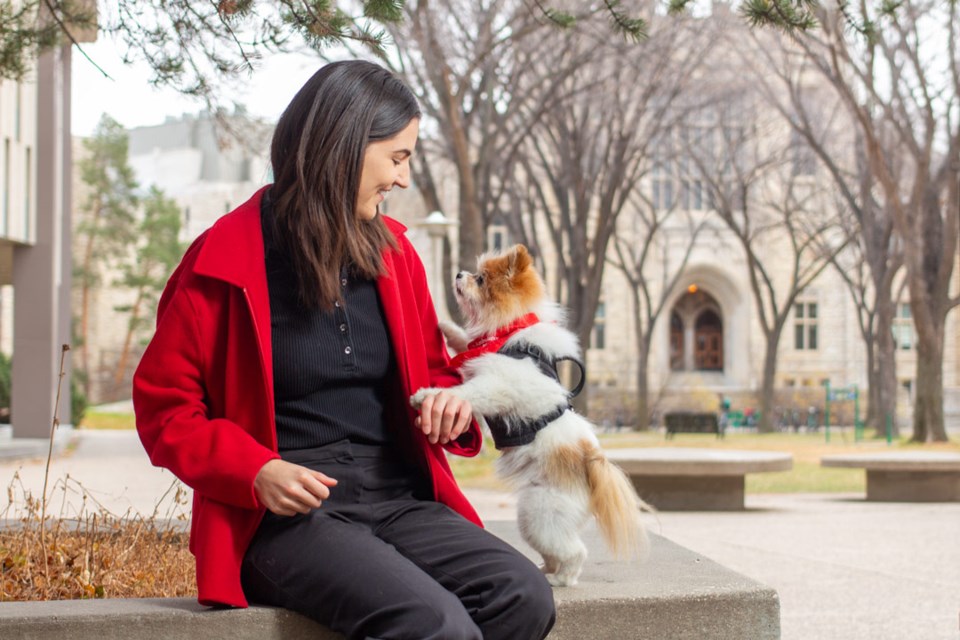SASKATOON — For graduating University of Saskatchewan (USask) student Amélia Katherine Gagnon, knowing herself and seeking opportunities to learn outside the classroom were some of the keys to academic success.
At USask Fall Convocation on Nov. 13, Gagnon will receive the President’s Medal: the award for the graduating student with the highest academic average in any USask undergraduate program. Gagnon, who is graduating with a Bachelor of Science in Cellular, Physiological and Pharmacological Sciences, will also receive the University Medal in BSc, Biomedical Sciences.
Gagnon is grateful to her fellow students, professors and family for their support throughout her degree, as well as to Cookie—the 10-year-old Pomeranian mix she has had since she was 12.
Cookie has been there for more than just Gagnon. In 2022, the pair became certified as a St. John Ambulance therapy dog team and began volunteering at PAWS Your Stress events on campus.
“I enjoyed being able to support other students, as a student, knowing some of the stress they might be going through,” Gagnon said.
Born in Ontario, Gagnon spent some of her earliest years living with her family in New Caledonia, a tiny French island territory near Australia. When she moved to Saskatoon at age 7, she spoke fluent French but little English and knew how to write in cursive but not print. The experience taught her to handle change.
“When you move at a young age, you acquire skills to adapt to different environments and people, as well as learn quickly,” she said.
Gagnon graduated high school from Marion M. Graham Collegiate during the COVID-19 pandemic and began classes at USask remotely.
“Starting university remotely fostered my ability to be independent and in charge of my own learning. Practicing these habits early helped throughout the rest of my degree when university went back to in-person,” she said.
Her love of science and some personal experiences with the health-care system helped guide Gagnon toward a cellular, physiological and pharmacological sciences major—a program offered by the College of Arts and Science in partnership with the College of Medicine.
“When I was fourteen, I had an immediate family member receive lifesaving care at the Royal University Hospital. I witnessed what is possible through medicine and care, which inspired me to pursue a path in the health field.”
Gagnon is considering becoming a pharmacist and is now applying to professional schools.
1. Find learning opportunities beyond the classroom
Gagnon spent a summer conducting breast cancer research under the supervision of College of Medicine faculty member Dr. Dean Chamberlain (PhD) through the Student Undergraduate Research Experience (SURE) program. That experience, which led to a job as a lab assistant, gave her hands-on experience with the tools and technologies she was learning about in her classes.
Gagnon also received a USask Global Engagement Scholarship that let her study abroad for part of a summer in France, where she shadowed the head of medical oncology and cellular therapy at a hospital in Paris. She got up close with the Canadian health-care system when she and Cookie signed on with the Saskatchewan Health Authority’s therapy dog program and began weekly visits to the biomedical imaging and elderly/dementia units at Royal University Hospital.
“We were able to bring some uplifting energy and support to staff members and patients, especially on harder days. It’s been special to be able to build these relationships throughout the community,” Gagnon said.
2. Take a variety of classes to broaden your perspective and thinking
Gagnon is especially glad she took a drawing course from the School for the Arts in her final year.
“I thought, OK, I’m in Arts and Science. I should take an art class,” she said. “So I’m now getting back into art—not just drawing, but pottery and ceramics, and also making stained glass art. The drawing foundations class reignited my passion for the arts and reminded me of the importance of introspection.”
3. Tailor your study strategies
Gagnon made sure to learn what study methods worked best for her and tailored her approach to her current class and professor. For other students, that might mean practicing written answers when you expect long-form questions on an exam or creating comparison tables and charts when the class calls for memorization.
“You can try studying in groups or individually, but know that what works for you might be different than your friends,” she said.
4. Be active
Gagnon loves snowboarding, but it wasn’t until she took a job as a snowboard instructor that she found time to do it routinely.
“If it's difficult to make the time to be active, sign up for something that will make you be active,” she said.
— Submitted by USask Media Relations




